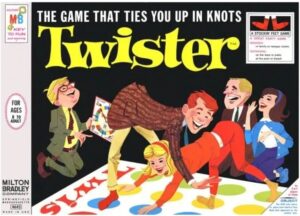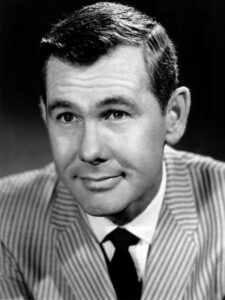By Sharon Oliver
Contributing Writer
SPRINGFIELD – There was a time when Milton Bradley, the Springfield-based game company, worried that the physically challenging game Twister would be too inappropriate for kids because of the required close contact of its players.
Originally marketed mostly to kids and teens, 1966 promotional materials featured cartoonish adult men in suits and ties. The women wore sweaters buttoned up to their necks while placing their hands and feet on brightly colored circles. Hardly practical attire for a group of males and females who will likely end up on the floor, limbs wrapped around each other like a heap of twisted pretzels. Still, overdressed cartoon figures did not scream “sex!” either.

A risk not worth taking
As development executive Mel Taft pushed Twister into the market, others felt the risk was not worth it. In an interview for his book “The Playmakers,” which is about the history of toys, author Tim Walsh said in Smithsonian Magazine that Taft caught quite a bit of flak from people internally at Milton Bradley. Furthermore, internal criticism revolved around Twister being a floor game instead of the normal tabletop games the manufacturer was known for. There were real concerns that “the game that ties you up in knots” would be perceived as too sexual.
Those fears grew in 1966 when department stores across the nation expressed skepticism and Sears department stores refused to stock the game because their representative said the game was “too risqué.” Walsh explained, “If Sears said we’re not buying this, it could be the death of a game because they had such a monopoly.” Minnesota design firm Reynolds Guyer House of Design owner and author of the book “Right Brain Red” wrote in his book, “They warned Mel that the idea of being that close to someone––especially someone of the opposite sex––was socially unacceptable. The rule we were breaking almost broke the deal. Thankfully, Mel Taft was a rule breaker too.” After hearing the news, Reyn Guyer wrote that “Twister was dead.”
One of the game’s co-creators, Neil Rabens, who still could not believe the success of the game spoke to KARE in 2016 and shared how he and his co-creator, Charlie “Chuck” Foley, who passed away in 2015, had different ideas for the game. Rabens stated, “I initially came up with the hand and foot thing.” Rabens envisioned players twisting separately in a game they first called “Pretzel.” Foley suggested rearranging the dots to tie players together.
Johnny Carson to the rescue
Despite innocent intentions, the game was viewed as scandalous when it was released in the 60s and was even called sex in a box. Then thanks to a pitch from a Milton Bradley salesperson, in steps an unlikely savior of the controversial game—the King of Late Night—Johnny Carson. On May 3, 1966, Carson played a game of Twister with actress Eva Gabor on “The Tonight Show.”

Photo/Wikimedia Commons
Mel Taft told The Guardian, “Someone brought out the mat, and Eva, God bless her, said, ‘What’s this, Johnny?’ When he saw she was interested, he made her get down on all fours and climbed on top of her. The camera was on both of them and her dress, very low-cut to begin with, dropped even lower. The audience went absolutely bananas.”
Sales explode
After that, the tide for Twister shifted almost overnight. Stores sold out quickly, including Sears, and by 1967, Twister had sold more than three million copies.
Games magazine included Twister in their “Top 100 Games of 1980,” praising it as being “nearly as well-known as Spin the Bottle, and ten times more enjoyable” and suggesting it is best played on a soft surface with people you’d like to know better.
The Milton Bradley company is credited by many for launching the board game industry. It entered millions of American households with the success of games like The Game of Life, Candyland, Operation, and Battleship. But it wasn’t until Twister’s introduction in the mid-1960s that the normally staid company became the target of moralists concerned that a simple game would lead to inappropriate sexual behavior.
But as the tidal wave of cultural change and loosening of sexual taboos crested later in the decade, Twister’s perceived threat receded dramatically. The game has been played by an estimated 65 million people around the world.
RELATED CONTENT:
How the Parker Brothers monopolized the game industry
Award-winning graphic designer now a game creator
‘Breck Girls’ shampoo ads set the standard for beauty












